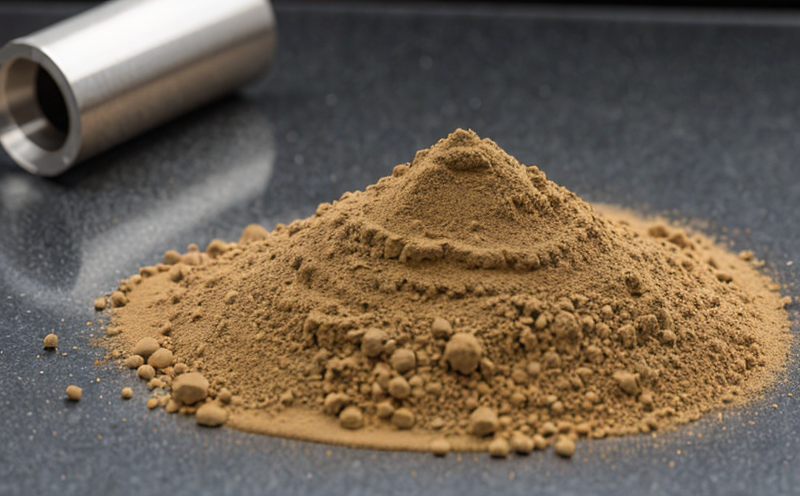ASTM D1921 Particle Size Distribution by Sieving Testing
The ASTM D1921 standard is a widely recognized method used to characterize the particle size distribution of powders and granular materials. This testing technique is essential for industries such as additive manufacturing, pharmaceuticals, and chemicals where material properties significantly influence product performance.
Particle size distribution (PSD) plays a crucial role in ensuring consistent quality across additive manufacturing processes. For instance, in laser powder bed fusion (LPBF), the particle size of raw materials can directly impact the surface roughness, porosity, and mechanical properties of the final part. Understanding and controlling the particle size distribution is vital for achieving optimal process parameters and product specifications.
The sieving method described in ASTM D1921 involves passing a sample through a series of progressively finer sieves, each with a specific mesh size. The weight retained on each sieve is then measured to determine the distribution of particles across different size ranges. This information is critical for quality assurance and compliance with industry standards.
One key advantage of this method is its simplicity and repeatability. It allows laboratories to perform precise measurements that can be easily reproduced, which is essential in R&D environments where consistent results are paramount. However, the method requires careful sample preparation and handling to ensure accurate measurements. Proper sieving techniques and appropriate sieve size selection are crucial for obtaining reliable data.
Another important aspect of ASTM D1921 testing is its role in quality control during production processes. By regularly characterizing raw materials using this method, manufacturers can monitor any changes in particle size distribution that may arise from processing or storage conditions. Early detection of such variations helps prevent costly rejections and ensures adherence to regulatory requirements.
The ASTM D1921 sieving test is also valuable for research purposes. Researchers often use this technique to study the effects of different raw materials on additive manufacturing processes. By comparing particle size distributions between various batches or types of powders, they can identify optimal conditions that enhance process efficiency and product quality.
Furthermore, the ASTM D1921 method is instrumental in ensuring compliance with international standards such as ISO 4360 and EN 15857. These standards provide guidelines for particle size analysis using sieving techniques, which are integral to maintaining consistent quality across global markets. Compliance with these standards not only enhances a company’s reputation but also facilitates easier market access in regions that have stringent regulatory requirements.
Given its importance in additive manufacturing and other industries reliant on powder materials, the ASTM D1921 sieving test remains an indispensable tool for material characterization. Its ability to provide detailed insights into particle size distribution makes it a cornerstone of quality assurance programs worldwide.
Benefits
- Enhanced Process Control: Ensures consistent raw material characteristics, leading to more predictable and reliable manufacturing processes.
- Improved Product Quality: By closely monitoring particle size distribution, manufacturers can optimize product performance and meet stringent quality standards.
- Regulatory Compliance: Meets international standards like ISO 4360 and EN 15857, ensuring compliance with global regulatory requirements.
- Research Support: Provides valuable data for academic and industrial research, facilitating advancements in additive manufacturing technologies.
- Informed Decision-Making: Enables informed decision-making regarding raw material selection and process optimization.
The benefits of ASTM D1921 sieving testing extend beyond immediate quality improvements. By providing detailed insights into particle size distribution, this method helps companies stay ahead in a competitive market by offering superior products that meet the highest standards. Additionally, it fosters continuous improvement initiatives aimed at enhancing overall operational efficiency and sustainability.
Eurolab Advantages
At Eurolab, we pride ourselves on providing accurate, reliable, and compliant testing services that meet the highest industry standards. Our team of experienced professionals ensures that every ASTM D1921 particle size distribution test is conducted with precision and care.
- Accreditation: We are ISO/IEC 17025 accredited, ensuring our tests adhere to international quality requirements.
- State-of-the-Art Equipment: Utilizing advanced sieving equipment tailored for ASTM D1921 testing guarantees accurate results every time.
- Comprehensive Reporting: Our reports not only include the test data but also detailed interpretations and recommendations, helping clients make informed decisions.
- Expertise: With a team of industry experts, Eurolab offers specialized knowledge in additive manufacturing and particle size distribution testing.
Our commitment to excellence extends beyond just meeting standards. We work closely with our clients to understand their specific needs and challenges, providing tailored solutions that enhance their competitive advantage. By leveraging our expertise and resources, companies can confidently rely on Eurolab for all their ASTM D1921 particle size distribution testing requirements.
Use Cases and Application Examples
| Application Example | Description |
|---|---|
| Laser Powder Bed Fusion (LPBF) | Ensuring consistent particle size distribution is critical for achieving optimal surface roughness, porosity, and mechanical properties in additive manufactured parts. |
| Pharmaceutical Manufacturing | Controlling the particle size of raw materials ensures uniform mixing and dissolution rates, which are essential for drug efficacy and patient safety. |
| Chemical Industry | In processes involving blending or milling, precise knowledge of particle size distribution helps optimize production efficiency and product quality. |
| Coatings and Paints | Understanding the particle size distribution in coatings ensures proper viscosity and application properties, leading to superior finishes. |
The ASTM D1921 sieving test finds applications across various industries where material characteristics significantly impact product performance. From additive manufacturing to pharmaceuticals and chemicals, this method plays a vital role in ensuring consistent quality and meeting regulatory requirements.
- Laser Powder Bed Fusion: Ensures optimal surface roughness, porosity, and mechanical properties of parts.
- Pharmaceutical Manufacturing: Guarantees uniform mixing and dissolution rates for drug efficacy and patient safety.
- Chemical Industry: Optimizes production efficiency by controlling blending or milling processes.
- Cosmetics: Ensures consistent texture and application properties in cosmetic products.
The versatility of ASTM D1921 particle size distribution testing allows it to be applied across a wide range of industries, making it an indispensable tool for quality assurance and process optimization.





